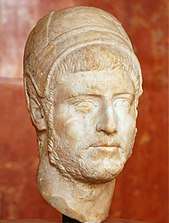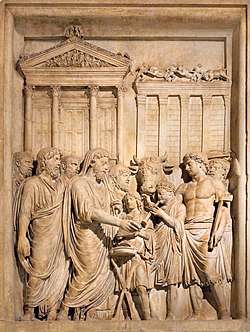Salii
In ancient Roman religion, the Salii (/ˈsæliaɪ/ SAL-ee-eye, Latin: [ˈsalɪ.iː]) were the "leaping priests" (from the verb saliō "leap, jump") of Mars supposed to have been introduced by King Numa Pompilius.[1] They were twelve patrician youths, dressed as archaic warriors: an embroidered tunic, a breastplate, a short red cloak (paludamentum), a sword, and a spiked headdress called an apex. They were charged with the twelve bronze shields called ancilia, which, like the Mycenaean shield, resembled a figure eight. One of the shields was said to have fallen from heaven in the reign of King Numa and eleven copies were made to protect the identity of the sacred shield on the advice of the nymph Egeria, consort of Numa, who prophesied that wherever that shield was preserved, the people would be the dominant people of the earth.
| Priesthoods of ancient Rome |
|---|
 Flamen (250–260 CE) |
| Major colleges |
|
Pontifices · Augures · Septemviri epulonum Quindecimviri sacris faciundis |
| Other colleges or sodalities |
| Fetiales · Fratres Arvales · SaliiTitii · Luperci · Sodales Augustales |
| Priests |
|
Pontifex Maximus · Rex Sacrorum Flamen Dialis · Flamen Martialis Flamen Quirinalis · Rex NemorensisCurio maximus |
| Priestesses |
| Virgo Vestalis MaximaFlaminica Dialis · Regina sacrorum |
| Related topics |
| Religion in ancient Rome · Imperial cultGlossary of ancient Roman religionGallo-Roman religion |
Each year in March, the Salii made a procession round the city, dancing and singing the Carmen Saliare. Ovid, who relates the story of Numa and the heavenly ancilia in his Fasti (3.259–392), found the hymn and the Salian rituals outdated and hard to understand. During the Principate, by decree of the Senate, Augustus' name was inserted into the song (Res Gestae 10). They ended the day by banqueting. Saliaris cena became proverbial for a sumptuous feast.
King Tullus Hostilius is said to have established another collegium of Salii in fulfillment of a vow which he made in the second war with Fidenae and Veii.[2] These Salii were also twelve in number, chosen from the Patricians, and appeared to have been dedicated to the service of Quirinus. They were called the Salii collini, Agonales, or Agonenses.[3]
It is unclear whether the primary aim of the ritual was to protect Rome's army, although this is the traditional view.
The Salii are sometimes credited with the opening and closing of the war cycle which would last from March to October.[4]
Founder
In addition to the myth of the ancile, several other explanations are offered in Greek and Latin sources for the founding of the priesthood. An origin among the Etruscans is attributed to a founding by Morrius, king of Veii. The Salii are also given an origin in connection with Dardanus and the Samothracian Di Penates, and the Salius who came to Italy with Evander and in the Aeneid competed in the funeral games of Anchises.[5] Indeed in book VIII of The Aeneid, while in the land of King Evander Aeneas is entertained by the Salii during a feast, who are commemorating the fame and feasts of Hercules.[6]
Ancient authors quoted by Maurus Servius Honoratus and Macrobius recorded that Salii had existed at Tibur, Tusculum and Veii even before their creation in Rome.[7][8]
Interpretations of the rituals
There is no single standing description of the Salii's rituals throughout the month of March from one of the ancient authors, and facts have to be reconstructed from multiple mentions in diverse works; however there are strong indications that the procession may actually have lasted a full 24 days, from March 1st which opened the festival till March 24th which closed it, with the procession moving from one station to another each day, and some revelling being held each evening; a complete assessment can be found in Smith, Wayte, & Marindin (1890).[9]
Wissowa
Classical philologist Georg Wissowa maintained that the ritual of the Salii is a war dance or a sword dance, with their costumes clearly indicating their military origin.[10]
Dumézil
Georges Dumézil interpreted the rituals of the Salii as marking the opening and the closing of the yearly war season. The opening would coincide with the day of the Agonium Martiale on March 19,[11] and the closing with the day of the Armilustrium on October 19. The first date was also referred to as ancilia movere, "to move the ancilia," and the second as ancilia condere, "to store (or hide) the ancilia."
Dumezil views the two groups of Salii — one representing Mars and the other Quirinus — as a dialectic relationship showing the interdependency of the military and economic functions in Roman society.[12][13][14][15]
Usener
Because the earliest Roman calendar had begun with the month of March, Hermann Usener thought the ceremonies of the ancilia movere were a ritual expulsion of the old year, represented by the mysterious figure of Mamurius Veturius, to make way for the new god Mars born on March 1.[16] On the Ides of March, a man ritually named as Mamurius Veturius was beaten with long white sticks in the sacrum Mamurii, in Usener's view as a form of scapegoating. Mamurius was the mythic blacksmith who forged eleven replicas of the original divine shield that had dropped from the sky.[17]
According to Usener and Ludwig Preller[18] Mars would be a god of war and fertility while Mamurius Veturius would mean "Old Mars". Mars is himself a dancer,[19] and the head of the Salian dancers, patrician young men whose parents were both living (patrimi and matrimi). Wissowa compares the Salii with the noble youth who dance the Lusus Troiae.[20] The ritual dance of the Salii would thus be a coalescence of an initiation into adulthood and war with a scapegoat ritual (see also pharmakos).
Nomenclature
.gif)
- Numa's Salii Palatini were dedicated to Mars surnamed Gradivus (meaning "he who walks into battle"), and were quartered on the Palatine Hill.
- Tullus' Salii Collini were dedicated to Quirinus, and were quartered on the Quirinal Hill.[24] Rosinus called them Agonenses Salii. The second group of Salii may in fact have been created during an Augustan reorganization of the priesthood. Paulus ex Festo p. 10 M reads: ... Agones dicebant montes, Agonia sacrificia quae fiebant in monte; hinc Romae mons Quirinalis Agonus et Collina Porta Agonensis: "Agones were called the mounts, Agonia the sacrifices that took place on the mounts; hence in Rome the Quirinal mount (is named) Agonus and the Porta Collina Agonensis".
Salian virgins
Sextus Pompeius Festus makes a perplexing reference to "Salian virgins" (saliae virgines).[25] Wearing the paludamentum and pointed apex of the Salii, these maidens were employed to assist the College of Pontiffs in carrying out sacrifices in the Regia. It has been suggested[26] that the passage in Festus describes a transvestite initiation.[27] An earlier explanation held that the maidens played the role of absent warriors in some form of propitiation.[28] The meaning of their being "hired" is unclear.[29]
References
- Notes
- Livy, Ab urbe condita libri, 1:20
- Livy, Ab urbe condita, 1:27
- William Smith's Dictionary of Greek and Roman Antiquities, "Salii". John Murray, London, 1875.
- Le Glay, Marcel. (2009). A history of Rome. Wiley-Blackwell. ISBN 978-1-4051-8327-7. OCLC 760889060.
- Joseph Rykwert, The Idea of a Town: The Anthropology of Urban Form in Rome, Italy and the Ancient World (MIT Press, 1988), p. 96.
- "The Aeneid Book VIII". Poetry in Translation.
- Servius. Aenead. VIII 285.
- Macrobius. Saturnalia. III 12, 1-9.
- Smith, William, LLD; Wayte, William; Marindin, G. E. (1890). A Dictionary of Greek and Roman Antiquities. Albemarle Street, London, UK: John Murray – via Tufts U. / Perseus.
- Wissowa 1912, pp. 480ff.
- Varro. Lingua Latina. VI 14.
Liberalia ... In libris Saliorum quorum cognomen Agonensium, forsitan hic dies ideo appellatur Agonia
[Liberalia ... In the books of the Salii they are named of the Agonenses, perhaps this day is thence rather named Agonia.] - Servius. Aenead. VIII 663.
- Statius. Silvae. V 128 ff.
- Dionysius of Halicarnassus. Roman Antiquities. II 70, 2.
- Dumezil, G. (1974). La religion romaine archaique. It. tr. Milano 1974 p. 248-249. Paris, FR. 2nd part 1 chapt. 6.
- Old calendars name the day Caesus Ancili or Natalis Martis: Calend. Philocali et Constantini Feriae Martis, Calend. Praen. CIL I p. 387; Ovid Fasti III 1 ff.; L. Preller Roemische Mythologie 1858 p.319 n. 5
- H. Usener Kleine Schriften IV Bonn, 1913 p. 122 and 135 citing Iohannes Lydus de Mensibus IV 36, 71; Properce V 2, 61; Minucius Felix Octav. 243; Varro Lingua Latina VI 45: "Itaque Salii quod cantant: "Mamuri Veturi" significant memoriam veterem". "Thus the Salii when they sing "Mamuri Veturi" mean memories of the past"
- H. Usener Kleine Schriften IV Bonn, 1913, p. 193; L. Preller Roemische Mythologie 1858 p. 297
- Catullus 17, 6 Salisubsulus
- Wissowa 1912, p. 382.
- L. von Schoeder Mysterium und Mimus im RigVeda 1908, pp. 126 and 329-330
- A. Hillebrandt Vedische Mythologie 1902 III p. 323; killer of his own father at the same time of his birth II p. 517, III p. 162; father of Indra is Tvastar the divine blacksmith (cf. Mamurius Veturius)
- Oldenburg Die Religion d. Veda 1894 p. 233
- Antonia Traiana Severa. "God Mars". religiioromana.net. Archived from the original on 2005-04-23.
- Festus (439 L) cites Aelius Stilo and Cincius as his sources.
- Versnel, H.S. (1994). Inconsistencies in Greek and Roman Religion: Transition and reversal in myth and ritual. 2 (2nd ed.). Brill. pp. 158, especially note 104. citing the prior but independent conclusions of Torelli, M. (1984). Lavinio e Roma. Riti iniziatici e matrimonio tra acheologia e storia. Rome. pp. 76 ff and 106 ff.
- On the aspect of initiation, see also Habinek, Thomas (2005). The World of Roman Song: From ritualized speech to social order. Johns Hopkins University Press. p. 17. ISBN 978-0-8018-8105-3.CS1 maint: ref=harv (link)
- L. Deubner, "Zur römischen Religionsgeschichte," Rheinisches Museum 36–37 (1921–22) 14 ff., as cited by Versnel.
- Beard, Mary (1990). "Priesthood in the Roman Republic". Pagan Priests: Religion and power in the ancient world. Cornell University Press. pp. 19 and 22.
- Sources
- Wissowa, Georg (1912). Religion und Kultus der Römer. C.H. Beck.CS1 maint: ref=harv (link)

